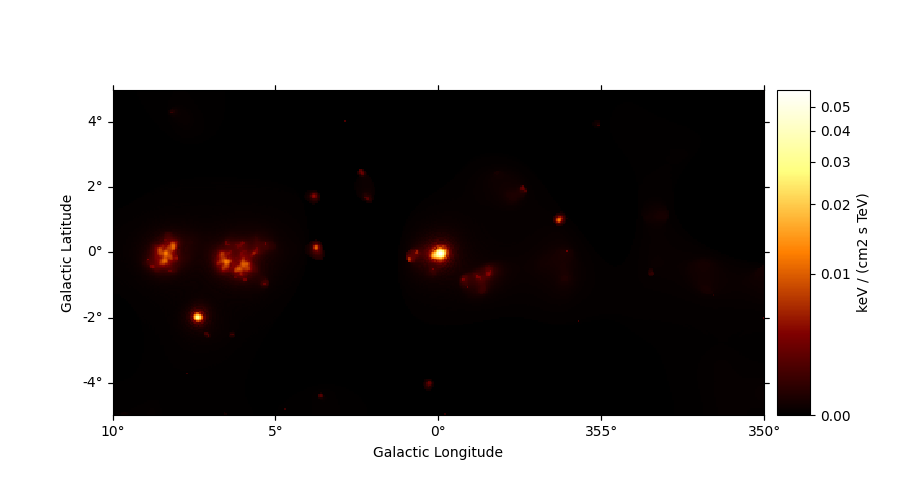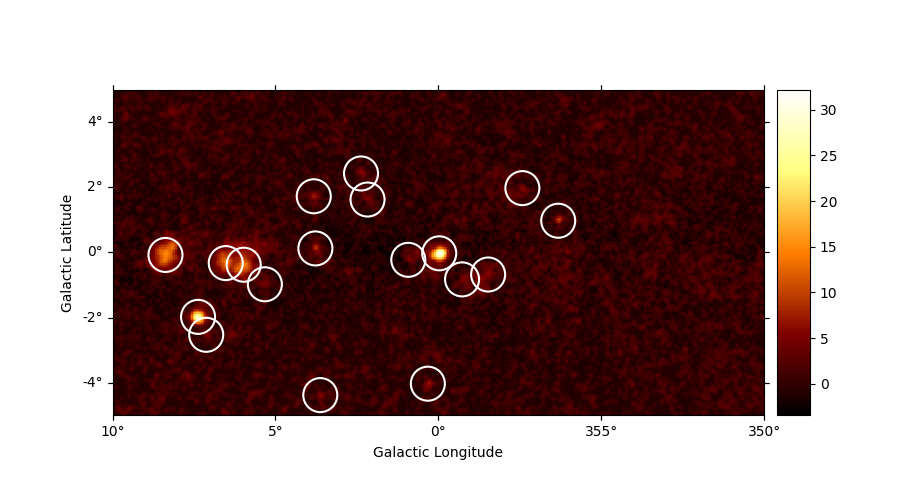Note
Go to the end to download the full example code or to run this example in your browser via Binder.
Source detection and significance maps#
Build a list of significant excesses in a Fermi-LAT map.
Context#
The first task in a source catalog production is to identify significant excesses in the data that can be associated to unknown sources and provide a preliminary parametrization in terms of position, extent, and flux. In this notebook we will use Fermi-LAT data to illustrate how to detect candidate sources in counts images with known background.
Objective: build a list of significant excesses in a Fermi-LAT map
Proposed approach#
This notebook show how to do source detection with Gammapy using the
methods available in estimators. We will use images from a
Fermi-LAT 3FHL high-energy Galactic center dataset to do this:
perform adaptive smoothing on counts image
produce 2-dimensional test-statistics (TS)
run a peak finder to detect point-source candidates
compute Li & Ma significance images
estimate source candidates radius and excess counts
Note that what we do here is a quick-look analysis, the production of real source catalogs use more elaborate procedures.
We will work with the following functions and classes:
Setup#
As always, let’s get started with some setup …
import numpy as np
import astropy.units as u
# %matplotlib inline
import matplotlib.pyplot as plt
from IPython.display import display
from gammapy.datasets import MapDataset
from gammapy.estimators import ASmoothMapEstimator, TSMapEstimator
from gammapy.estimators.utils import find_peaks, find_peaks_in_flux_map
from gammapy.irf import EDispKernelMap, PSFMap
from gammapy.maps import Map
from gammapy.modeling.models import PointSpatialModel, PowerLawSpectralModel, SkyModel
Read in input images#
We first read the relevant maps:
counts = Map.read("$GAMMAPY_DATA/fermi-3fhl-gc/fermi-3fhl-gc-counts-cube.fits.gz")
background = Map.read(
"$GAMMAPY_DATA/fermi-3fhl-gc/fermi-3fhl-gc-background-cube.fits.gz"
)
exposure = Map.read("$GAMMAPY_DATA/fermi-3fhl-gc/fermi-3fhl-gc-exposure-cube.fits.gz")
psfmap = PSFMap.read(
"$GAMMAPY_DATA/fermi-3fhl-gc/fermi-3fhl-gc-psf-cube.fits.gz",
format="gtpsf",
)
edisp = EDispKernelMap.from_diagonal_response(
energy_axis=counts.geom.axes["energy"],
energy_axis_true=exposure.geom.axes["energy_true"],
)
dataset = MapDataset(
counts=counts,
background=background,
exposure=exposure,
psf=psfmap,
name="fermi-3fhl-gc",
edisp=edisp,
)
/home/runner/work/gammapy-docs/gammapy-docs/gammapy/.tox/build_docs/lib/python3.11/site-packages/astropy/wcs/wcs.py:918: FITSFixedWarning: 'datfix' made the change 'Set DATEREF to '2001-01-01T00:01:04.184' from MJDREF.
Set MJD-OBS to 54682.655283 from DATE-OBS.
Set MJD-END to 57236.967546 from DATE-END'.
warnings.warn(
Adaptive smoothing#
For visualisation purpose it can be nice to look at a smoothed counts image. This can be performed using the adaptive smoothing algorithm from Ebeling et al. (2006).
In the following example the threshold
argument gives the minimum significance expected, values below are clipped.
scales = u.Quantity(np.arange(0.05, 1, 0.05), unit="deg")
smooth = ASmoothMapEstimator(threshold=3, scales=scales, energy_edges=[10, 500] * u.GeV)
images = smooth.run(dataset)
plt.figure(figsize=(9, 5))
images["flux"].plot(add_cbar=True, stretch="asinh")
plt.show()

TS map estimation#
The Test Statistic, \(TS = 2 \Delta log L\) (Mattox et al. 1996), compares the likelihood function L optimized with and without a given source. The TS map is computed by fitting by a single amplitude parameter on each pixel as described in Appendix A of Stewart (2009). The fit is simplified by finding roots of the derivative of the fit statistics (default settings use Brent’s method).
We first need to define the model that will be used to test for the existence of a source. Here, we use a point source.
spatial_model = PointSpatialModel()
# We choose units consistent with the map units here...
spectral_model = PowerLawSpectralModel(amplitude="1e-22 cm-2 s-1 keV-1", index=2)
model = SkyModel(spatial_model=spatial_model, spectral_model=spectral_model)
Here we show a full configuration of the estimator. We remind the user of the meaning of the various quantities:
model: aSkyModelwhich is converted to a source model kernelkernel_width: the width for the above kerneln_sigma: number of sigma for the flux errorn_sigma_ul: the number of sigma for the flux upper limitsselection_optional: what optional maps to computen_jobs: for running in parallel, the number of processes used for the computationsum_over_energy_groups: to sum over the energy groups or fit thenormon the full energy cube
estimator = TSMapEstimator(
model=model,
kernel_width="1 deg",
energy_edges=[10, 500] * u.GeV,
n_sigma=1,
n_sigma_ul=2,
selection_optional=None,
n_jobs=1,
sum_over_energy_groups=True,
)
maps = estimator.run(dataset)
Accessing and visualising results#
Below we print the result of the TSMapEstimator. We have access to a number of
different quantities, as shown below. We can also access the quantities names
through maps.available_quantities.
print(maps)
FluxMaps
--------
geom : WcsGeom
axes : ['lon', 'lat', 'energy']
shape : (np.int64(400), np.int64(200), 1)
quantities : ['ts', 'norm', 'niter', 'norm_err', 'npred', 'npred_excess', 'stat', 'stat_null', 'success']
ref. model : pl
n_sigma : 1
n_sigma_ul : 2
sqrt_ts_threshold_ul : 2
sed type init : likelihood
fig, (ax1, ax2, ax3) = plt.subplots(
ncols=3,
figsize=(20, 3),
subplot_kw={"projection": counts.geom.wcs},
gridspec_kw={"left": 0.1, "right": 0.98},
)
maps["sqrt_ts"].plot(ax=ax1, add_cbar=True)
ax1.set_title("Significance map")
maps["flux"].plot(ax=ax2, add_cbar=True, stretch="sqrt", vmin=0)
ax2.set_title("Flux map")
maps["niter"].plot(ax=ax3, add_cbar=True)
ax3.set_title("Iteration map")
plt.show()

The flux in each pixel is obtained by multiplying a reference model with a normalisation factor:
print(maps.reference_model)
SkyModel
Name : wj6OkAd0
Datasets names : None
Spectral model type : PowerLawSpectralModel
Spatial model type : PointSpatialModel
Temporal model type :
Parameters:
index : 2.000 +/- 0.00
amplitude : 1.00e-22 +/- 0.0e+00 1 / (keV s cm2)
reference (frozen): 1.000 TeV
lon_0 : 0.000 +/- 0.00 deg
lat_0 : 0.000 +/- 0.00 deg
maps.norm.plot(add_cbar=True, stretch="sqrt")
plt.show()

Source candidates#
Let’s run a peak finder on the sqrt_ts image to get a list of
point-sources candidates (positions and peak sqrt_ts values). The
find_peaks function performs a local maximum search in a sliding
window, the argument min_distance is the minimum pixel distance
between peaks (smallest possible value and default is 1 pixel).
sources = find_peaks(maps["sqrt_ts"], threshold=5, min_distance="0.25 deg")
nsou = len(sources)
display(sources)
# Plot sources on top of significance sky image
plt.figure(figsize=(9, 5))
ax = maps["sqrt_ts"].plot(add_cbar=True)
ax.scatter(
sources["ra"],
sources["dec"],
transform=ax.get_transform("icrs"),
color="none",
edgecolor="w",
marker="o",
s=600,
lw=1.5,
)
plt.show()

value x y ra dec
deg deg
------ --- --- --------- ---------
32.194 200 99 266.41449 -28.97054
27.833 52 60 272.43197 -23.54282
15.16 32 98 271.16056 -21.74479
14.134 69 93 270.40919 -23.47797
13.872 80 92 270.15899 -23.98049
9.7638 273 119 263.18257 -31.52587
8.793 124 102 268.46711 -25.63326
7.3491 123 134 266.97596 -24.77174
6.8071 193 19 270.59696 -30.69138
6.2432 152 148 265.48068 -25.64323
5.8704 230 86 266.15140 -30.58926
5.6678 127 12 272.77351 -27.97934
5.6557 251 139 262.90685 -30.05853
5.4712 181 95 267.17020 -28.26173
5.4209 214 83 266.78188 -29.98429
5.1736 57 49 272.82739 -24.02653
5.067 156 132 266.12148 -26.23306
5.0414 93 80 270.37773 -24.84233
We can also utilise find_peaks_in_flux_map
to display various parameters from the FluxMaps
sources_flux_map = find_peaks_in_flux_map(maps, threshold=5, min_distance="0.25 deg")
display(sources_flux_map)
x y ra dec ... stat_null success flux flux_err
deg deg ... 1 / (s cm2) 1 / (s cm2)
--- --- --------- --------- ... ---------- ------- ----------- -----------
93 80 270.37773 -24.84233 ... 840.62111 True 8.105e-11 2.332e-11
156 132 266.12148 -26.23306 ... 692.59451 True 5.880e-11 1.859e-11
57 49 272.82739 -24.02653 ... 723.70546 True 5.572e-11 1.729e-11
214 83 266.78188 -29.98429 ... 838.88781 True 9.695e-11 2.583e-11
181 95 267.17020 -28.26173 ... 659.39224 True 1.286e-10 3.165e-11
251 139 262.90685 -30.05853 ... 766.22149 True 6.664e-11 1.913e-11
127 12 272.77351 -27.97934 ... 433.37517 True 4.107e-11 1.349e-11
230 86 266.15140 -30.58926 ... 865.54892 True 1.278e-10 3.040e-11
152 148 265.48068 -25.64323 ... 611.76473 True 7.080e-11 1.876e-11
193 19 270.59696 -30.69138 ... 445.28958 True 6.612e-11 1.711e-11
123 134 266.97596 -24.77174 ... 655.77218 True 9.207e-11 2.123e-11
124 102 268.46711 -25.63326 ... 881.98258 True 1.702e-10 3.050e-11
273 119 263.18257 -31.52587 ... 846.92490 True 1.763e-10 2.947e-11
80 92 270.15899 -23.98049 ... 1093.46225 True 4.576e-10 5.278e-11
69 93 270.40919 -23.47797 ... 1044.25763 True 4.553e-10 5.259e-11
32 98 271.16056 -21.74479 ... 1036.42361 True 5.401e-10 5.794e-11
52 60 272.43197 -23.54282 ... 1092.41995 True 5.984e-10 4.669e-11
200 99 266.41449 -28.97054 ... 137.30287 True 1.414e-09 7.898e-11
Note that we used the instrument point-spread-function (PSF) as kernel, so the hypothesis we test is the presence of a point source. In order to test for extended sources we would have to use as kernel an extended template convolved by the PSF. Alternatively, we can compute the significance of an extended excess using the Li & Ma formalism, which is faster as no fitting is involve.
What next?#
In this notebook, we have seen how to work with images and compute TS and significance images from counts data, if a background estimate is already available.
Here’s some suggestions what to do next:
Look how background estimation is performed for IACTs with and without the high level interface in High level interface and Low level API notebooks, respectively
Learn about 2D model fitting in the 2D map fitting notebook
Find more about Fermi-LAT data analysis in the Fermi-LAT with Gammapy notebook
Use source candidates to build a model and perform a 3D fitting (see 3D detailed analysis, Multi instrument joint 3D and 1D analysis notebooks for some hints)
Total running time of the script: (0 minutes 17.734 seconds)
